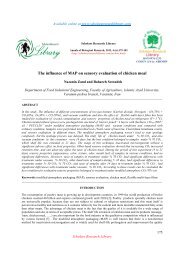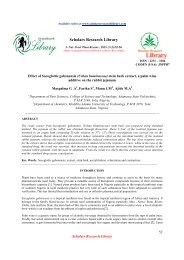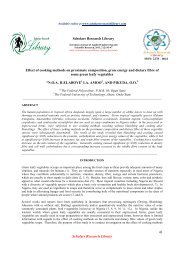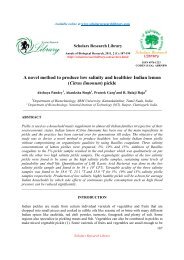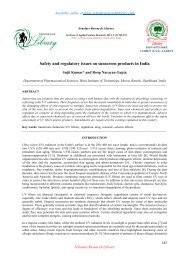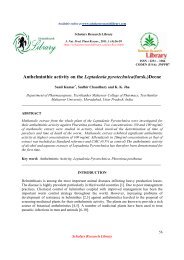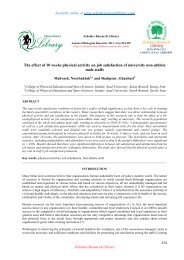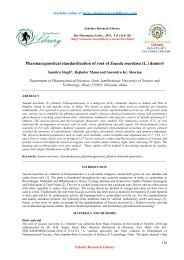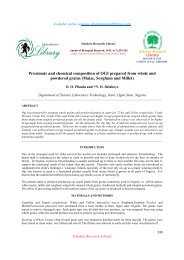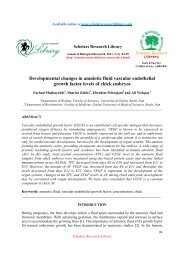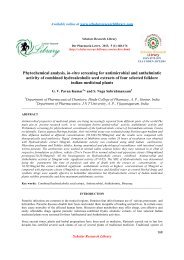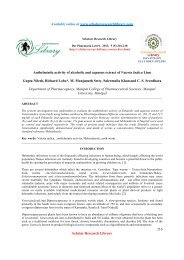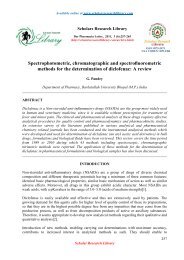Anthelmintic activity of Cassia auriculata L. extracts-In vitro study
Anthelmintic activity of Cassia auriculata L. extracts-In vitro study
Anthelmintic activity of Cassia auriculata L. extracts-In vitro study
You also want an ePaper? Increase the reach of your titles
YUMPU automatically turns print PDFs into web optimized ePapers that Google loves.
Sucheta A Gaikwad et al J. Nat. Prod. Plant Resour., 2011, 1 (2): 62-66<br />
______________________________________________________________________________<br />
to tropical regions and pose a great threat to health and contribute to the prevalence <strong>of</strong><br />
malnutrition, anaemia, eosinophilia and pneumonia[3].Parasitic diseases cause severe morbidity<br />
affecting mainly population in endemic areas with major economic and sol consequences[4]. The<br />
gastro-intestinal helminthes becomes resistant to currently available anthelmintic drugs therefore<br />
there is a foremost problem in treatment <strong>of</strong> helminthes diseases[5]. There is an increasing<br />
demand towards natural anthelmintics. The plant C.<strong>auriculata</strong> L. is an aromatic more or less<br />
deciduous shrub found through out <strong>In</strong>dia up to an altitude <strong>of</strong> 1,500 m commonly in forests. C.<br />
<strong>auriculata</strong> L. (Caselpinaceae) is a tall, much branched bushy shrub growing wild throughout<br />
forests and along roadsides and in wastelands. Literature survey reveals that leaves <strong>of</strong> C.<br />
<strong>auriculata</strong> L are useful in treatment <strong>of</strong> leprosy, ulcers and have anthelmintic <strong>activity</strong>[6]. The<br />
anthelmintic <strong>activity</strong> <strong>of</strong> quath extract <strong>of</strong> the leaves is reported[7]. The plant is reported for the<br />
presence <strong>of</strong> polyphenolic compounds.anthelmintic <strong>activity</strong>, chemically tannins are polyphenolic<br />
compounds[8]. Some synthetic phenolic anthelmintics e.g. niclosamide, oxyclozanide and<br />
bithionol are shown to interfere with energy generation in helminth parasites by uncoupling<br />
oxidative phosphorylation[9]. Another possible anthelmintic effect <strong>of</strong> tannins is that they can<br />
bind to free protein in the gastrointestinal tract <strong>of</strong> host animal or glycoprotein on the cuticle <strong>of</strong><br />
the parasite and cause death[10].The present <strong>study</strong> investigates the anthelmintic <strong>activity</strong> <strong>of</strong> the<br />
leaves for the different <strong>extracts</strong> with a view to justify the use <strong>of</strong> the plant in the treatment <strong>of</strong><br />
helminths.<br />
MATERIALS AND METHODS<br />
1. Plant materials and preparation <strong>of</strong> <strong>extracts</strong><br />
<strong>Cassia</strong> <strong>auriculata</strong> L was collected from Western Pune, Maharashtra, <strong>In</strong>dia. The taxonomic<br />
identification was carried out with the help <strong>of</strong> Flora <strong>of</strong> Botany Presidency and Flora <strong>of</strong><br />
Maharashtra (Singh et al.2000) and herbaria were prepared by following standard methods. The<br />
specimens were also compared with the authentic herbaria <strong>of</strong> BSI, Western circle<br />
Pune,Maharashtra,<strong>In</strong>dia for confirming the identification, its number is BSI/WC/Tech/2009/95.<br />
Air shade dried and pulverized plant material was used. Extracts were prepared using exact<br />
weighed sample powder in the measured volume <strong>of</strong> solvents like, acetone, ethanol, methanol<br />
and quath.Vaccum dried extracs are used for the experiment.Solvents used after distillation.<br />
2. Phytochemical screening<br />
Qualitative assay, for the presence <strong>of</strong> plant phytoconstituents such as carbohydrates, alkaloids,<br />
glycosides, flavonoids, tannins and saponins were carried out on following standard procedure<br />
[7,11].<br />
3.Collection <strong>of</strong> Animal<br />
The anthelmintic assay was carried as per the method <strong>of</strong> Ajaiyeoba et. al. [9,14] with minor<br />
modifications[12,15]. The assay was performed on adult earthworm (Eicinia fetida) owing to its<br />
anatomical and physiological resemblance with the intestinal roundworm parasites <strong>of</strong> human<br />
beings[13,14]. Easy availability <strong>of</strong> earthworms prompts their extensive use for preliminary in<br />
<strong>vitro</strong> evaluation <strong>of</strong> anthelmintic compounds[10]. Earthworms were provided and identified by<br />
Dept. <strong>of</strong> Entomology, College <strong>of</strong> Agriculture, Pune,Maharashtra,<strong>In</strong>dia. All earthworms were <strong>of</strong><br />
approximately equal size (15 cm). They were washed with saline before experiment.<br />
Scholar Research Library<br />
63



